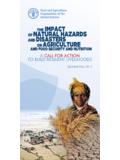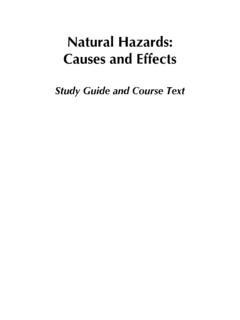Transcription of Natural Hazards as Disasters: Mitigation and Challenges in ...
1 Journal of Emerging Trends in Educational Research and Policy Studies (JETERAPS) 5(1):14-19 (ISSN:2141-6990) 14 Natural Hazards as Disasters: Mitigation and Challenges in Southern Zimbabwe 1 Nkululeko Joshua Ndiweni and Charles Musarurwa 1 Department of Geography and 2 Population Studies, Lupane State University, Zimbabwe. 2 Department of Languages and Social Sciences Education, University of Botswana. Corresponding Author: Nkululeko Joshua Ndiweni _____Abstract This position paper focuses on drought related disasters in southern Zimbabwe. Generally, the so-called Natural disasters (drought included) are in many instances a result of a complex range of factors that include not only Natural causes, but human-induced climate change as well. This has resulted in increased frequency and magnitude of weather related Hazards such as droughts, tropical cyclones, heat waves and floods.
2 However, southern Zimbabwe in particular is normally hit by droughts claiming livestock, reducing food production, thus perpetuating food insecurity and triggering increased migration. This increased vulnerability is compounded by the fact that economically southern Zimbabwe is a peripheral area that has experienced minimal development. Furthermore, the local communities of the region lack relevant drought Mitigation skills and resources. If community preparedness and building resilience are to be effectively inculcated to mitigate drought related disasters in the region, then a sustained effort is needed to strengthen research by linking scientists, practitioners and policymakers in order to show how climate change influences vulnerability. Therefore the purpose of this paper is explore drought Mitigation Challenges in southern Zimbabwe and how poverty, high population growth and how land use in these marginal and fragile areas have increased human vulnerability to this type of disaster .
3 This is significant in that planners and policy makers will manage to build resilience in affected communities and redress environmental degradation and desertification. _____ Keywords: Natural Hazards and disasters, drought, vulnerability, Mitigation , adaptation and resilience. _____INTRODUCTION Over much of the earth s history, climate has been varying from warm to cold and from wet to dry and back again (Tarbuck and Lutgens, 2010). This spatial and temporal variation in climate is associated with Natural Hazards such as tropical cyclones, droughts, heat waves and floods. The objective of this study is to explore Challenges for drought Mitigation in southern Zimbabwe, those conditions of the people that make it possible for a drought to become a disaster . In other words, it will be shown how so-called Natural disasters (drought) are in many instances the result of a complex range of factors than just Natural causes.
4 Anthropogenic activities have intensified the rate of climate change and increased the frequency and magnitude of Natural Hazards . The Inter-governmental Panel on Climate Change [IPCC] (2012) states climate change may be due to Natural internal or external processes or to persistent anthropogenic changes in the composition of the atmosphere or land use. Human activities have speeded-up climate change such that it is very difficult for vulnerable groups to cope with the change. According to Smolka (2006), the frequency of major Natural catastrophes is increasing. This assertion has been reinforced by IPCC (2012) when it states that a changing climate leads to changes in the frequency, intensity, spatial extent, duration and timing of extreme weather and climate events and can result in unprecedented extreme weather and climate events.
5 Thus one can argue that, in the present is the time of increasing vulnerability to extreme Natural Hazards , as people occupy marginal areas due to high population growth and over reliance on Natural resources. Vulnerability refers to the propensity of exposed elements such as human beings, their livelihoods and assets to suffer adverse effects when impacted by hazard events (Thywissen, 2006). Economic activities have led to the alteration of the atmosphere due to the burning of fossil fuels. Agricultural activities have led to the reduction of carbon sinks as land is cleared for cultivation. When the land is bare carbon stored in soil is released. Deforestation continues to contribute to global warming and is a major cause of the greenhouse effect (African Ministerial Conference on the Environment [AMCEN], 2011).
6 Industrial and agricultural activities have led to the emission of large quantities of greenhouse gases such as carbon dioxide and trace gases (methane, nitrous oxide and chlorofluorocarbons). According to a 2007 report by the IPCC, the atmospheric concentrations of carbon dioxide in 2005 exceeded, by far, the Natural range Journal of Emerging Trends in Educational Research and Policy Studies (JETERAPS) 5(1): 14-19 Scholarlink Research Institute Journals, 2013 (ISSN: 2141-6990) Journal of Emerging Trends in Educational Research and Policy Studies (JETERAPS) 5(1):14-19 (ISSN:2141-6990) 15 (180-300ppm) over the past 650 000 years (Tarbuck and Lutgens, 2010). Greenhouse gases form a blanket-like layer in the lower atmosphere, thereby trapping outgoing terrestrial radiation and leading to the warming of the lower layers of the atmosphere which is referred to as global warming.
7 The warming has accelerated due to high concentrations of greenhouse gases from factories, automobiles and agricultural activities. Global warming has triggered a high frequency, magnitude and intensity in extreme weather events. A warmer earth has more energy and models of the atmosphere suggest more extreme events (IPCC, 2012). However, the question of whether global warming can cause increases in extreme weather events is still unresolved (Karl et al, 1997 and Mitchell et al, 2006). An increase in extreme weather events has been accompanied by an increase in poverty in most developing countries, especially in sub-Saharan Africa since poor communities are more vulnerable to these Natural Hazards . When Natural Hazards negatively impact on disadvantaged communities they are referred to as Natural disasters.
8 Extreme weather and climate events, interacting with exposed and vulnerable human and Natural systems, can lead to disaster (IPCC, 2012). Southern Zimbabwe is highly vulnerable to droughts and according to AMCEN (2011) the underlying cause is climate change. The area is drier, with an average rainfall of 450mm or less per year. Studies have shown that every three to five years the zone is affected by a drought reducing both harvests and pastures. The Zimbabwe Vulnerability Assessment Committee [ZimVac] (2010) outlines that the livelihoods in this zone are characterized by animal husbandry, mainly cattle rearing as well as limited food and cash cropping. A typical better off household owns 30-40 cattle, around 40 goats and sheep, maybe some pigs and 4-5 donkeys (ZimVac, 2010). Erratic rains are a barrier to sustainable agriculture and other livelihood options.
9 Droughts are very rampant as they have led to the death of large numbers of livestock per year and cause crops to fail thereby leading to food insecurity and the famines. According to the figures released by the Department of Livestock Production and Development in the province, 12 721 cattle were lost in 2012 due to poverty-induced deaths, Mangwe district had the highest number of casualties (6 885) followed by Matobo (1 885), Bulilima (1 436), Beitbridge (1 015), Gwanda (812), Insiza (665) and Umzingwane (23) (Nsingo, 2013). Human vulnerability to Natural Hazards is spearheaded by unequal development. Extreme poverty makes it very difficult for people to withstand Natural Hazards , thereby turning these Hazards into disasters with catastrophic consequences. The character and severity of impacts from climate extremes depend not only on the extremes themselves but also on exposure and vulnerability (IPCC, 2012).
10 On the other hand, as stated by Kofi Annan in Fara (2001), it is human behaviour that transforms Natural Hazards into what should be called unnatural disasters. The impacts of drought are exacerbated by human activities such as deforestation, overgrazing and poor cropping methods, which reduce soil water retention and improper soil conservation techniques, which lead to soil degradation (AMCEN, 2011). It is, therefore, the aim of this study to explore Challenges for drought Mitigation in southern Zimbabwe. The study will focus on those conditions of the people that will make it possible for a drought to become a disaster . In other words, it will be shown how so-called Natural disasters (drought) are in many instances the result of a complex range of factors than just Natural causes. STATEMENT OF THE PROBLEM The problem is lack of socioeconomic development, marginality, inaccessible information related to early warnings, response strategies, coping and adaptation mechanisms, drought Mitigation is also a challenge because it is very difficult to determine its onset, extent and end and is commonly the result of a number of factors and the other challenge for drought management is that Mitigation measures are a relatively low priority for African decision-and policy-makers, however, as Hazards and disasters often pale into insignificance when compared to other pressing issues such as poverty and HIV and AIDS.









